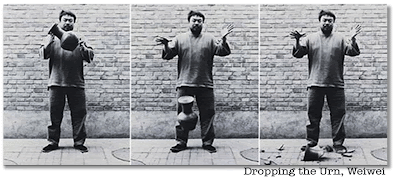
The Visitor Experience of museum goers and photography
visitors in particular enter public collections with a mindset that we may not be able to imagine. We expect that they go with all kinds of aspirations and expectations – but we might reasonably assume to participate in the muse.
Increasingly it seems that they wish to contextualise the meanings and cultural cargo the cultural production in museum/gallery collections carry – and beyond the visit.
The growing number of independent Internet facilitated discourses available to emergent idiosyncratic audiences, via BLOGs in particular, evidences this. They are networking ideas that are not being explored by the 'official' cultural critics. These ideas are sometimes outrageous but so be it.
The growing number of independent Internet facilitated discourses available to emergent idiosyncratic audiences, via BLOGs in particular, evidences this. They are networking ideas that are not being explored by the 'official' cultural critics. These ideas are sometimes outrageous but so be it.
These discourses are reaching wider and wider audiences in multiple contexts and arguably from an enormous array of cultural perspectives informed by a diversity of sensibilities and sensitivities.
Increasingly, the primacy of ’text’ is being challenged given the advances in technology that allow for the relatively easy transmission of imagery – static and moving – often supported by sound – spoken language, music, soundscapes, etc. All of this facilitates nuisances of a kind difficult or impossible to achieve via text alone.
Furthermore, images – photographic and other – transmit ideas more quickly and more effectively than large slabs of text.
In the light of this, restricting museum/gallery visitors’ experiences is arguably inappropriate given the array of options and opportunities notionally open to them in a contemporary context. Indeed, there is good case for the bureaucratic naysaying to be regarded as being excessive and reactionary.
 |
| CLICK HERE TO GO TO SOURCE |
Rather than controlling the free flow of knowledge, museums/galleries need to be facilitating it – and especially so in publicly funded institutions.
Restrictive and repressive ‘photography policies’ are at best inappropriate in the context of a 21st C museum/gallery.
They represent a kind of blatant disservice to its COI and oftentimes an insult to the intelligence and cultural sensibilities of COI members – visitors, cultural producers, researchers et al.
Museums/art gallery’s deliberately aspiring towards accountable sustainability need a full set of tools in order to be able to meet their own expectations let alone those of their COIs. In this, and a 21st C context, photography policies move from being in some assumed discretionary context to one that is ‘marketing based’. Sadly sometimes marketing people imagine that they are gatekeepers of some kind, often with little or no DOMAINknowledge, trying to second guess what people want.
 |
| CLICK HERE FOR A CONTEXT |

No comments:
Post a Comment